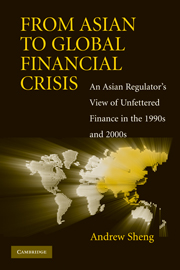 From Asian to Global Financial Crisis
From Asian to Global Financial Crisis Book contents
- Frontmatter
- Contents
- List of Figures
- List of Tables
- Acknowledgements
- Introduction
- 1 Things Fall Apart
- 2 Japan and the Asian Crisis
- 3 The Beam in Our Eyes
- 4 Banking: The Weakest Link
- 5 Washington Consensus and the IMF
- 6 Thailand: The Karma of Globalization
- 7 South Korea: Strong Body, Weak Heart
- 8 Malaysia: The Country That Went Its Own Way
- 9 Indonesia: From Economic to Political Crisis
- 10 Hong Kong: Unusual Times Need Unusual Action
- 11 China: Rise of the Dragon
- 12 From Crisis to Integration
- 13 The New World of Financial Engineering
- 14 What's Wrong with Financial Regulation?
- 15 The Global Financial Meltdown
- 16 A Crisis of Governance
- From Asian to Global Crisis: Chronology of Notable Events
- Abbreviations and Acronyms
- Bibliography
- Index
15 - The Global Financial Meltdown
Published online by Cambridge University Press: 05 June 2012
- Frontmatter
- Contents
- List of Figures
- List of Tables
- Acknowledgements
- Introduction
- 1 Things Fall Apart
- 2 Japan and the Asian Crisis
- 3 The Beam in Our Eyes
- 4 Banking: The Weakest Link
- 5 Washington Consensus and the IMF
- 6 Thailand: The Karma of Globalization
- 7 South Korea: Strong Body, Weak Heart
- 8 Malaysia: The Country That Went Its Own Way
- 9 Indonesia: From Economic to Political Crisis
- 10 Hong Kong: Unusual Times Need Unusual Action
- 11 China: Rise of the Dragon
- 12 From Crisis to Integration
- 13 The New World of Financial Engineering
- 14 What's Wrong with Financial Regulation?
- 15 The Global Financial Meltdown
- 16 A Crisis of Governance
- From Asian to Global Crisis: Chronology of Notable Events
- Abbreviations and Acronyms
- Bibliography
- Index
Summary
International financial crises, I might even say domestic financial crises, are built into the human genome. When we map the whole thing, we will find something there called greed and something called fear and something called hubris. That is all you need to produce international financial crises in the future.
~ Paul VolckerThe end of a journey always comes back to its beginning. Why do financial crises occur? Do they have the same root causes? Are the solutions the same? Ten years after the Asian crisis ended, the U.S. subprime crisis by Christmas 2008 had plunged the world into a deep recession that is still unfolding. Future historians will no doubt compare the 2008 crisis with the Great Depression of the 1930s, which led up to the Second World War and changed the financial landscape for nearly 80 years. Similarly, the present crisis is likely to induce profound changes in economic theory, philosophical outlook and institutional structure.
The famous Mr Yen, Dr Eisuke Sakakibara, pronounced in 1999, after he stepped down as Vice Minister of Finance for International Affairs, that the Asian crisis was not ‘Asian’, but ‘a crisis of global capitalism’. Even then, he understood the inherent instability of liberalised capital markets where sudden reversals of market confidence cause periodic panics of differing magnitudes and durations. Former U.S. Treasury Secretary Larry Summers already recognized as early as February 1998 that ‘It is important to recognize that this is a distinct kind of crisis. It has a common element with almost all financial crises: money borrowed in excess and used badly. But it is also profoundly different because it does not have its roots in improvidence: excessive budget deficits, excess rates of inflation or insufficient rates of saving’.
- Type
- Chapter
- Information
- From Asian to Global Financial CrisisAn Asian Regulator's View of Unfettered Finance in the 1990s and 2000s, pp. 375 - 395Publisher: Cambridge University PressPrint publication year: 2009


